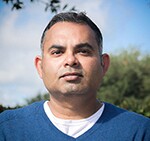The scientific research process begins as one tries to find explanations for a phenomenon. We make observations, define the problem statement, and review the existing domains of research that could be used. Another approach is to explore theoretical problems, those that are purely conceptual at present but provide a solution when a related observation is made in the future.
Though these approaches sound isolated, both are part of characterizing uncertainty, and uncertainty comes in all scales and dimensions. This challenges us to learn at all scales possible, from the fume hoods in the laboratory to magnificently exposed outcrops and through deep narrow boreholes that drill through subsurface reservoirs. The combined efforts often convert learnings to actionable intelligence.
At a smaller scale, porosity and permeability are probably the two most-studied rock properties among those that have meaningful implications for hydrocarbon reservoirs. Paper SPE 216856 considers machine-learning (ML) methods for classifying reservoir texture at a microscale. Borehole-image logs long have been used to obtain a picture of subsurface reservoirs. Unfortunately, a majority of the observations are qualitative. Quantifying these features faces the challenge of continuity, upscaling, and regional correlation. As we explore the latitude of ML-based applications, the use of these techniques for quantifying image logs becomes very relevant. The authors of that paper contribute to quantifying textural features at a “fume-hood scale” and develop a work flow with the potential for estimating properties such as porosity and permeability from a different domain of reservoir characterization.
I often wonder how much the domain on formation evaluation encompasses. While geoscience-driven reservoir characterization is a big part of it, how reservoirs change over time also is a complementary observation. Paper URTeC 3864861 discusses various aspects of geomechanical changes that a hydraulically fractured reservoir goes through during its life cycle. The authors here study the relationship between measured strain from the fiber-optic sensors and wellhead pressure. Research like this could be extended to predicting production profiles and estimating recovery factors, which are important considerations in designing a stimulation program for sustaining production, maximizing recovery, and improving financial matrices for the capital program.
I believe information could be categorized as learning, knowledge, and intelligence. Any scientific process starts with set of careful observations bound by an envelope of hypotheses. This is learning. Learning, which could be verified by predictable and repeatable outcomes from carefully designed experiments of complementing domains, becomes knowledge. Actionable knowledge, which then could be used to alter an outcome or a process, becomes intelligence.
Paper URTeC 3871303 discusses a development strategy in a restrictive development unit with an existing parent well. Here, considerations are heavily weighted toward optimizing both interwell spacing and capital efficiency. The search for answers to a problem like this must seek guidance from a variable-scale experiment.
The study here establishes the big picture with the structural elements of the basin that could restrict both the continuity of the reservoir and the nature of the producible fluid. With this framework, the model is then set to iterate from several different perspectives. Potential interwell communications are explored by measuring fracture-driven interactions (FDIs) and quantifying stimulated reservoir volume. What is impressive here is the different domains from which the authors seek answers.
Direct observations from acoustic-fiber measurements for FDI and the geochemistry of produced fluids for identifying unique signatures from vertically separated formations are individual domains that seek the same answers in various scales. The study recommends the optimal spacing between wells and a stimulation design that minimizes well interference, reduces competition for resources between wells, and avoids overcapitalizing the program. This is how knowledge transforms into intelligence.
I hope the readers appreciate the scales of characterization in these three papers. As a student of geology, I have always been fascinated by the concept of scale and its relation to the domains of science that we deal with. Unlike general relativity and quantum mechanics, most geologic phenomena are observed in all scales. It is just the uncertainty that needs to be quantified.
This Month’s Technical Papers
Multidisciplinary Approach Optimizes Characterization, Completion in Shale Play
Approach to Perforation Interval Selection Uses AI-Assisted Image Interpretation
Fiber-Optic Strain Measurements Aid Fracture Characterization
Sandeep Mukherjee, SPE, is a geosciences adviser at Callon Petroleum. He holds a master’s degree in geology from the University of Minnesota. Mukherjee’s area of expertise lies within the various domains of formation evaluation. He is a member of the JPT Editorial Review Board.

